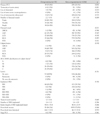1. Avezum A, Makdisse M, Spencer F, et al. Impact of age on management and outcome of acute coronary syndrome. Am Heart J. 2005. 149:67–73.
2. Batchelor WB, Anstrom KJ, Muhlbaier LH, et al. Contemporary outcome trends in the elderly undergoing percutaneous coronary interventions: results in 7,472 octogenarians. J Am Coll Cardiol. 2000. 36:723–730.
3. Kobayashi Y, Mehran R, Mintz GS, et al. Comparison of in-hospital and one-year outcomes after multiple coronary arterial stenting in patients ≥80 years old versus those <80 years old. Am J Cardiol. 2003. 92:443–446.
4. Liistro F, Colombo A. Coronary angioplasty in elderly patients. Ital Heart J Suppl. 2002. 3:1–8.
5. Park JC, Jeong MH, Kim JH, et al. Clinical characteristics of coronary interventions in old aged patients. Korean Circ J. 1998. 28:256–261.
6. Skolnick AH, Alexander KP, Chen AY, et al. Characteristics, management, and outcomes of 5,557 patients age≥90 years with acute coronary syndromes. J Am Coll Cardiol. 2007. 49:1790–1797.
7. De Gregorio J, Kobayashi Y, Albiero R, et al. Coronary artery stenting in the elderly: short-term outcome and long-term angiographic and clinical follow-up. J Am Coll Cardiol. 1998. 32:577–583.
8. Floyd KC, Jayne JE, Kaplan AV, et al. Age-based differences of percutaneous coronary intervention in the drug-eluting stent era. J Interv Cardiol. 2006. 19:381–387.
9. Vijayakumar M, Lemos PA, Hoye A, et al. Effectiveness of sirolimus-eluting stent implantation for the treatment of coronary artery disease in octogenarians. Am J Cardiol. 2004. 94:909–913.
10. Chung WS, Kim CJ, Seung KB, et al. Characteristics of coronary artery stenting in the elderly over 70 years old: short-term outcome and long-term angiographic and clinical follow-up. Korean Circ J. 2001. 31:996–1003.
11. Hassani SE, Wolfram RM, Kuchulakanti PK, et al. Percutaneous coronary intervention with drug-eluting stents in octogenarians: characteristics, clinical presentation, and outcomes. Catheter Cardiovasc Interv. 2006. 68:36–43.
12. Guagliumi G, Stone GW, Cox DA, et al. Outcome in elderly patients undergoing primary intervention for acute myocardial infarction: result from the controlled abciximab and device investigation to lower late angioplasty complications (CADILLAC) trial. Circulation. 2004. 110:1598–1604.
13. Mehta RH, Sadiq I, Goldberg RJ, et al. Effectiveness of primary percutaneous coronary intervention compared with that of thrombolytic therapy in elderly patients with acute myocardial infarction. Am Heart J. 2004. 147:253–259.
14. Lim SY, Jeong MH, Yang BR, et al. Long-term clinical outcomes after primary percutaneous coronary intervention in patients with acute myocardial infarction older than 75 years. Korean Circ J. 2005. 35:613–619.
15. Yang B, Choi MJ, Jeong MH, et al. The effect of gender on short- and long-term clinical outcomes of percutaneous coronary intervention in Korean octogenarians. Korean Circ J. 2002. 32:864–871.
16. Lee SH, Jeong MH, Park OY, et al. Early outcome and restenosis rate after coronary artery stenting in the elderly. Korean Circ J. 2001. 31:31–38.
17. Kang KT, Jeong MY, Kim JW, et al. A case of successful coronary stenting in a ninety three-year-old patient. Korean Circ J. 1998. 28:1790–1793.
18. Hassani SE, Wolfram R, Xue Z, et al. Clinical outcomes following percutaneous coronary intervention with drug-eluting stents in octogenarians. J Am Coll Cardiol. 2006. 4B. Abstract.
19. Kasper DL, Fauci AS, Longo DL, et al. Azotemia, urinary abnormalities. Harrison's Principles of Internal Medicine. 2005. 16th ed. McGraw Hill;247.
20. Ryan TJ, Faxon DP, Gunnar RM, et al. Guidelines for percutaneous transluminal coronary angioplasty: a report of the American College of Cardiology/American Heart Association Task Force on Assessment of Diagnostic and Therapeutic Cardiovascular Procedures. Circulation. 1988. 78:486–502.
21. Rihal CS, Textor SC, Grill DE, et al. Incidence and prognostic importance of acute renal failure after percutaneous coronary intervention. Circulation. 2002. 105:2259–2264.
22. Graham MM, Norris CM, Galbraith PD, Knudtson ML, Ghali WA. Quality of life after coronary revascularization in the elderly. Eur Heart J. 2006. 27:1690–1698.
23. Abizaid AS, Mintz GS, Abizaid A, et al. Influence of patient age on acute and late clinical outcomes following Palmaz-Schatz coronary stent implantation. Am J Cardiol. 2000. 85:338–343.






 PDF
PDF ePub
ePub Citation
Citation Print
Print






 XML Download
XML Download